1992 French Grand Prix: Back In The Groove
Mansell heads another easy Williams one-two, after Patrese plays the team game…
Nigel Mansell had several uneasy moments while winning his sixth GP of the season in Magny Cours, but none of them came from the opposition. After the glitches of Monaco and Montreal the Williams steamroller rumbled efficiently back into action, and nobody ever looked likely to offer it a run. That became certainty as early as the first lap when an altercation between Ayrton Senna and Michael Schumacher sent the World Champion home to the pits for an early changes of clothes and ruined the young German’s chances in an event for which the Benetton Ford had strongly been fancied.
It was, admitted Schumacher, his fault. He resumed in last place after a stop for a new nose, and when the race was halted at the 19 lap mark because of rain, the two met again on the grid for a discussion. Senna was through for the day, but Schumacher was ready for a long charge towards the points. Their conversation was not positive, and Michael was wound up tight as the field took off again. By the Adelaide hairpin, scene of the Senna incident, he was out for good after aviating over Stefano Modena’s rear wheel following a misunderstanding on lines. After all the impressive races he’s had since Spa last year, a bad one was, perhaps, inevitable.
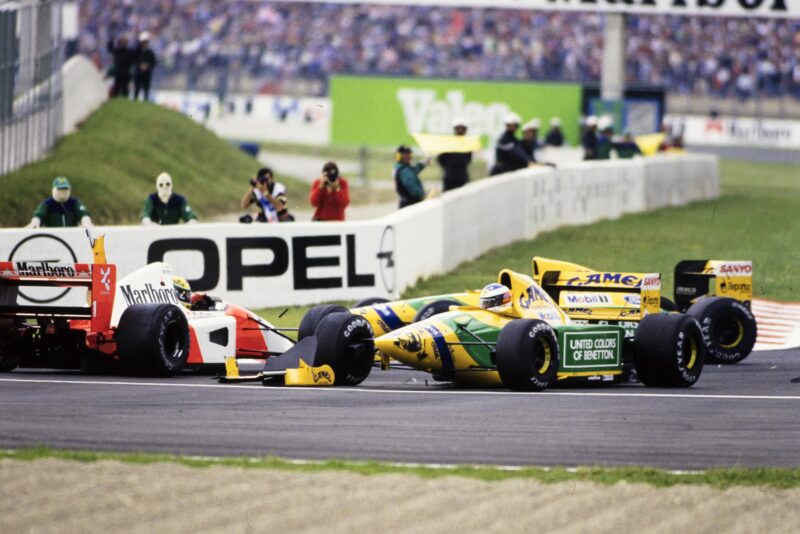
Ayrton Senna and Michael Schumacher come together at the start
Motorsport Images
No, it was thus neither Senna nor Schumacher who posed Mansell’s threat. Nor even Canadian victor Gerhard Berger. An awful French GP ended for McLaren Honda when his engine broke after a mere 11 laps, but by then it was already obvious that the ground McLaren and Honda appeared to have made on Williams and Renault in Canada had either been slightly illusory or else regained. Most observers felt it was the former.
It was, instead, Riccardo Patrese who posed the greatest threat to Mansell. A Patrese who seemed more atop the driving style requirements of his active FW14B here than at any time this season since Interlagos.
Mansell it was, predictably, who was fastest in Friday’s free practice, but where it took him 24 laps to do 1m 15.724s Riccardo, delayed initially by a gearbox software fault which slurred the downchanges, did his 1m 15.912s on his eighth. It was only a little thing, and Nigel had already stopped out on the circuit in his RS4-powered race chassis when the fuel system cut the engine, but it was a sign that the Italian was having one of his ‘strong’ weekends. There was more evidence at the start, too. Mansell had taken the pole, a 24th matching the achievements of Niki Lauda and Nelson Piquet, but Riccardo got off the line better. Perhaps the overriding reason was that he had been told that the team wouldn’t be keeping for 1993 — paddock rumour was already suggesting a deal with Benetton. Whatever, he was 1.184s clear of the Briton after only two laps. Mansell began to work away at that, though, and by lap 15 the two Williamses were less than a second apart. Mansell looked down the inside at the hairpin that time round, and then on lap 16 tried again on the outside in a prolonged attack that saw the two FW14Bs alongside each other all the way from Adelaide to Nurburgring, the right-left flick that follows the short straight out of the hairpin. It was gripping stuff as they were only inches apart, but Riccardo held firm and Nigel had to concede. It was shaping up into a real dogfight as Mansell dropped back and then began to attack again, but then the rain spots that had fallen between laps five and eight returned in more grown-up form. As cars began to slide around — (surely that’s what the new regulations were designed to achieve for 1993?) — FISA starter Roland Bruynseraede took the premature decision to terminate the race. As it transpired, by the time everyone had gathered on the start/finish line ready for a restart, what little rain there had been had gone and everyone stayed on slicks, so without that decision things could have carried on as normal and the fight would have continued. On such things does Fate turn.
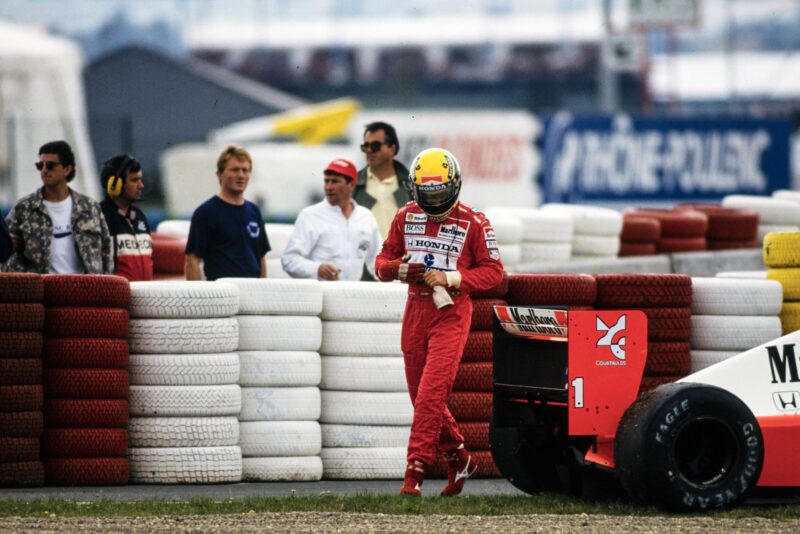
Senna walks away from his McLaren after being forced to retire from the race
Motorsport Images
Once again Patrese won the start, but Mansell was very fired up and quickly ducked down the inside going into Adelaide. During the ‘intermission’ Riccardo had been advised that he could defend his position, but not to the point where it might endanger the team: what this effectively meant was don’t get in Nigel’s way because he’ll keep pushing and it may all put a one-two at risk. With the President of Renault and the French government watching, that would be catastrophic. Senna and Schumacher were out, but there was no way Mansell was going to settle for only six points, no matter what the risk, so Riccardo had to be prepared to concede. What that did to his psyche can be imagined, while it cannot have been an easy thing to say for the man who had to tell him, either.
Riccardo thus decided to stage his own protest. He did so by immediately repassing Mansell at Imola, the right/left flick that follows the 180 degree left-hander after Nurburgring. They came down the hill to Lycée, the last corner, with White 6 leading Red 5, and Riccardo was credited with leading the lap as they crossed the line. Immediately thereafter, however, he ostentatiously waved his team-mate by, giving clear indication to the observers who mattered most that team orders had been deployed.
Afterwards his face was as clouded as the weather had become, his comments made dead-pan but heavily laced with irony. “I make no comment,” he said after a long pause following questions about team orders. “There is not really much to say about waving Nigel by, from my point of view. Let’s say that Nigel was pressing me very hard, and I thought that it was best for the team to let him go.” Again, the voice was remote, the tone one of hurt. After all, he had said nothing in Brazil where it was not he who had temporarily switched off his rev limiter to the rage of Bernard Dudot. “I think that the team did a fantastic job: first and second places again. It is my usual place and I am very comfortable with it.”
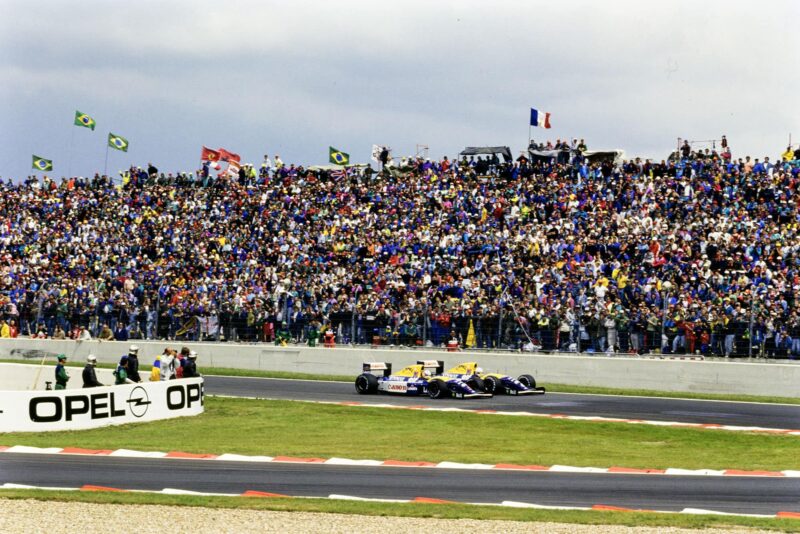
Nigel Mansell dives down the inside of team-mate Riccardo Patrese
Motorsport Images
Quite possibly he would not have been able to fend off Mansell anyway, the way the Briton is driving this year, but it would have been nice to see the battle go all the way.
As it was, Mansell sped away in another of his 1992 machinery-maximising drives and the issue was clear cut from that moment barring mechanical failure. When it began to rain heavily from the 46 lap mark he continued happily, and at 5.5s his switch from slicks to wet Goodyears was one the race’s fastest. From then until the 27th victory of his career his only worries were two moments in the ess leading to Lycée, where the wet surface had been rendered even slippier when Alesi’s engine broke on lap 62.
That was one of the great tragedies of a lacklustre French GP, for Jean had driven brilliantly in a Ferrari which had marginally been improved by revised front suspension pick-ups yet was otherwise simply being bent to its driver’s will. And what will! When the track was at its wettest the Franco-Sicilian was very nearly as fast on his slicks as Mansell was on wets, and all that only a week after a big testing accident at Silverstone had actually split his helmet when the rear wing broke at Becketts! After donning wets on lap 50, without losing the lead, Mansell was lapping in the 1m 33s. In the Ferrari the irrepressible Alesi was doing 1m 34s laps in a dramatic demonstration of sheer car control as the F92A squirmed and wriggled its way round in a ball of spray. At one stage he lost it briefly, but there he was at the end of that lap, going as hard as ever. By that stage it was more than obvious that the weather wasn’t going to improve, even though Hakkinen stayed out for a relatively long time on slicks too, and Lotus team-mate Herbert even longer, but eventually all three came in. At Lotus it was part of the strategy to call Hakkinen in on lap 53 and Herbert on lap 55, but at Ferrari Sante Ghedini was screaming at his driver as he resolutely stayed out until the 57th.
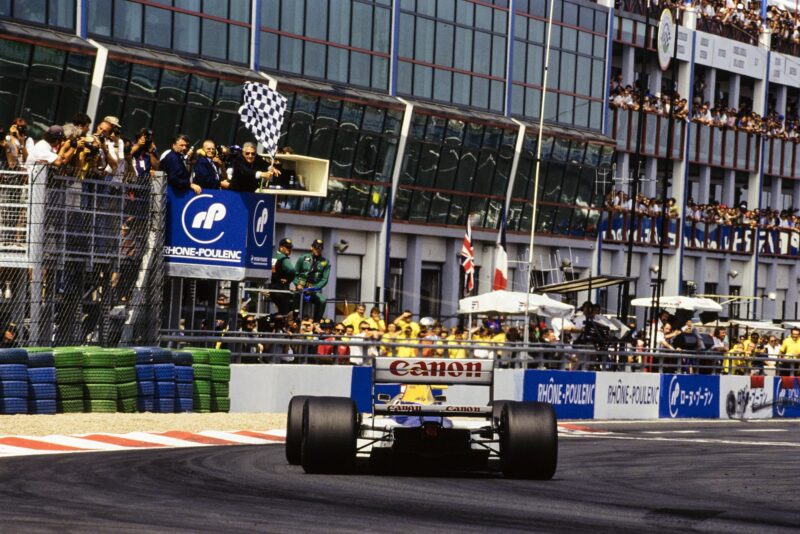
Mansell crosses the line to win the French Grand Prix
Motorsport Images
He had just been making serious inroads into Patrese’s on-the-road advantage (although Riccardo still had a time advantage in what had become a confusing race due to the two ‘heats’). And then disaster struck. It was a fast stop, 6.6s, but then the engine stalled. By the time he rejoined the chase was over. Worse, Brundle had repassed for third place. The Briton had comfortably stayed ahead-of the Ferrari in the first part of the race, as Alesi had had his hands full fending off an aggressive Hakkinen. (Indeed, the Lotus driver had actually claimed fourth place briefly before being baulked out of it by the tedious backmarker Olivier Grouillard). In the second half Martin was less competitive, plagued by a worsening problem with the Ford HB cutting out every so often as an electrical lead chafed. He was thus consigned to an attempt to survive at all costs, and when Alesi was delayed he moved smoothly into third place, thankful that the now diabolical conditions had alleviated his main problem by lessening the cornering loads. Behind him, Alesi was going as hard as ever, until he appeared on lap 62 trailing the same plume of smoke that had terminated Ivan Capelli’s uninspired run in eighth place on his 39th lap. The team felt it had made some progress on the power front that weekend, but reliability had again suffered.
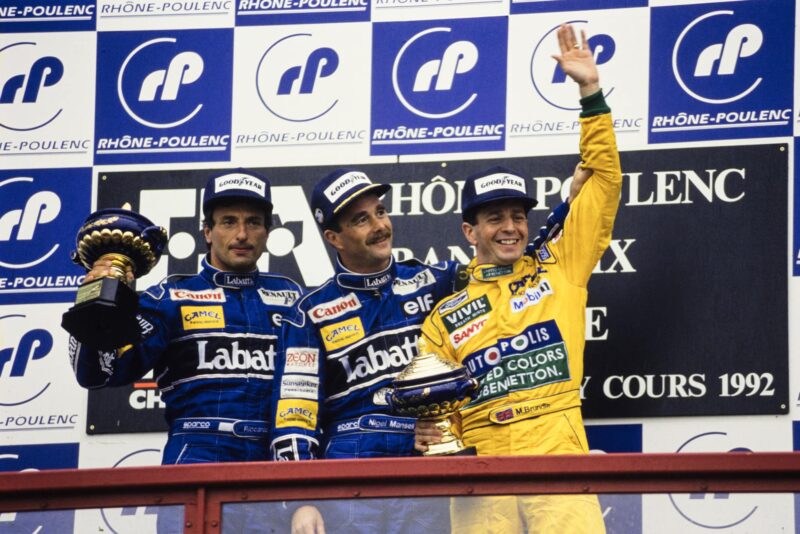
Martin Brundle beams on the podium alongside winner Mansell and Patrese
Motorsport Images
With Alesi’s demise the electricity went out of the race, but there was still an absorbing battle for fourth place. All weekend the Ligiers had been much closer to the pace than one had come to expect of late, thanks to suspension and aerodynamic modifications and the fact that they were racing on their home circuit. Some also suggested that they had works Renault engines and special Elf fuel similar to Williams’, rather than their customer Meccachrome motors for this special occasion. What was clear was that the JS37s had good traction out of the final corner, and in the race Boutsen and Comas circulated in close company in sixth and seventh places for much of the way until the unfortunate Belgian spun in a treacherously slippery Lycée on lap 48. Hakkinen had just rotated there but got going again, but Thierry had already lost his clutch and there was no way he could keep the Renault V10 running, much less restart it. Comas thus inherited that position, and then climbed to fourth by lap 63 after Alesi’s misfortune. Both Lotuses were flying, however, having recovered from their tyre stops. Hakkinen’s was handling better since Herbert was plagued by serious understeer throughout, and both were running in passive form after continuing hydraulic problems in qualifying. Bit by bit the Finn edged closer to the Frenchman as Herbert in turn was catching them both despite his handicap, and all three of them were in the hunt for three points. By this stage Comas’ engine was cutting out intermittently, it was thought because of water in the electrics, and suddenly a six second advantage over Hakkinen had gone. The Finn pounced on lap 68, while Herbert got them both on his last lap but didn’t quite manage to pull far enough ahead of the blue car to take fifth place on elapsed time. Nevertheless, though the pace of the Lotuses has now become familiar since Monaco, their reliability surprised many as they led home Alboreto. “Seventh place yet again!” — said the man who had finished every 1992 so far. Morbidelli was a reliable eighth from a meeting in which Minardi lost Christian Fittipaldi’s services for at least six weeks after the Brazilian cracked a vertebra after a practice accident, while Lehto and Martini soldiered on in Dallara-Ferraris that had only marginally been improved by stiffened suspension components. For Mansell it was just the antidote he needed after the disappointments of Monaco and Montreal as he drew himself level with Stewart’s British mark of 27 GP successes going into the British GP that he loves so much, and for Brits in general it was a welcome, unfamiliar sight to see three drivers in the top six. The last time that happened was at Rio in 1989 when Mansell won with Herbert fourth and a delayed Warwick fifth, while it was, Mansell remarked, the first time he had ever shared a rostrum with a fellow countryman. For British motorists affected by the French truck drivers’ blockades during the race week, that at least was consolation. D J T
